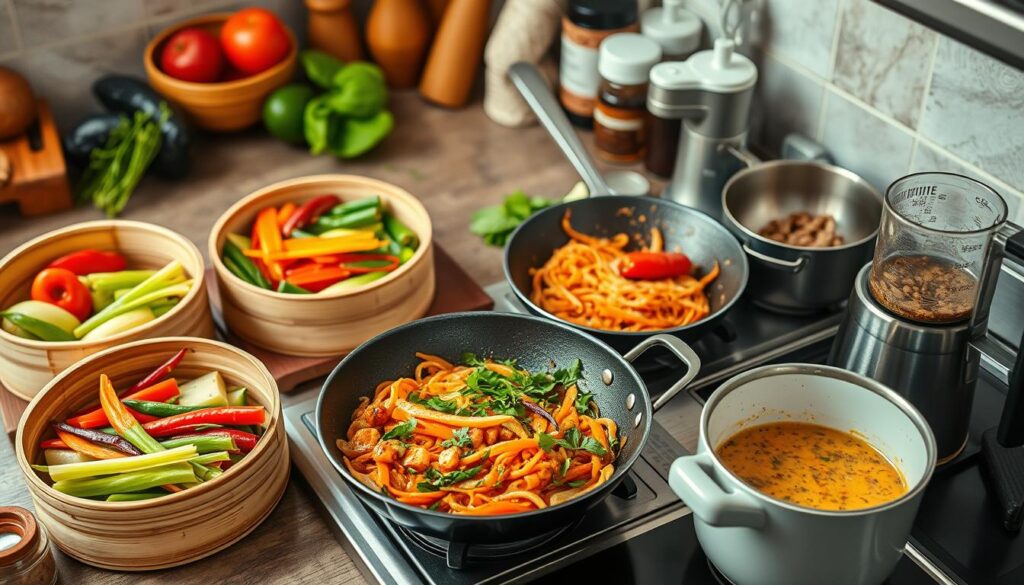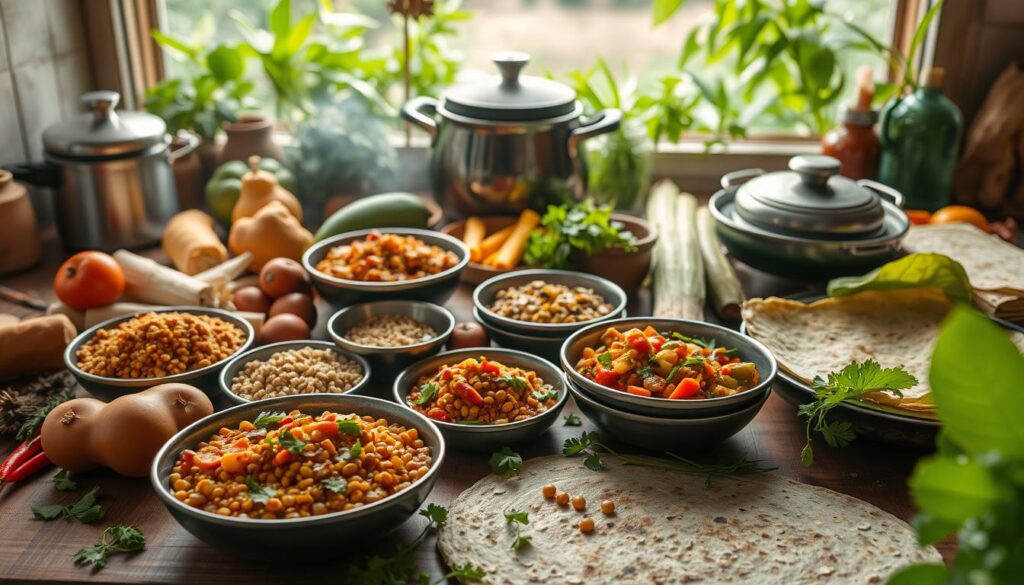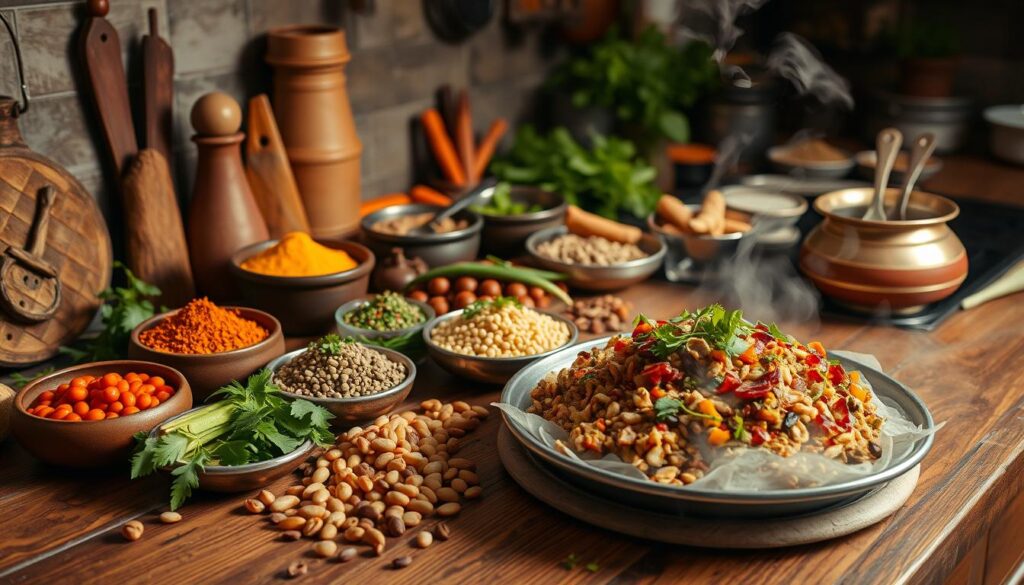The Art of Zero Oil Cooking
FITNESS Clean Eating, Healthy Cooking, Low-Fat Cooking, Oil-Free RecipesIndian kitchens now buzz with a new sound, where pans sizzle without oil. Zero oil cooking brings a fresh twist to old recipes, making them healthier. It’s a dance of steam, spice, and patience that reveals new flavors.
Amaresh Kumar Hanuman leads this cooking revolution. He shows us that oil-free dishes can be just as tasty as traditional ones. Each dish is a masterpiece, where spices like turmeric and cumin shine, making healthy cooking a labor of love. It’s a journey of discovery, not sacrifice.
Key Takeaways
- Zero oil cooking revitalizes Indian cuisine through innovative techniques
- Healthier meals maintain authentic flavors using steam and spices
- Expert guidance helps master oil-free recipes for daily use
- Traditional dishes adapt to modern wellness needs seamlessly
- Nutrient-rich meals support long-term health without compromising taste
The Poetry of Oil-Free Culinary Creation
In India’s kitchens, a change is happening. Once, cooks used golden oils. Now, they use no oil at all. This change brings out the true flavors of spices and uses steam as a cooking tool.
Ancient Wisdom in Modern Kitchens
Long before nonstick pans, Indian cooks found ways to cook without much oil. They used clay pots and banana leaves to keep food moist. Today, these old methods are coming back:
- Dum cooking: Sealed pots trap steam for biryanis
- Phaulkas: Whole wheat breads cooked dry on tawa
- Bhunna: Spice-toasting in iron kadhai without oil
The Symphony of Steam and Spice
Steam makes food tender. A mix of cinnamon, jackfruit, and peppercorns cooks together without oil. Chef Amaresh Kumar Hanuman says:
“When you remove oil, spices sing in their true voice—raw, bold, unapologetic.”
| Dish | Traditional Method | Oil-Free Adaptation |
|---|---|---|
| Aloo Gobi | Fried potatoes & cauliflower | Steam-roasted with ajwain |
| Dal Tadka | Tempered with ghee | Smoked via charcoal infusions |
| Poha | Cooked in mustard oil | Hydrated with vegetable broth |
Breaking Free from Traditional Boundaries
No oil cooking methods are changing the game. Ragi dosas are made crispy on granite stones. Tomato pulp replaces fat in kormas. Pressure cookers make dal makhani without ghee, using cashew paste for creaminess. It’s not just about cutting out oil; it’s about making food better.
Understanding Zero Oil Cooking: A Paradigm Shift
Cooking without oil is not deprivation—it’s freedom. Imagine spices dancing in steam, not floating on grease. Or vegetables caramelizing in their own sweetness, not drowning in fat. This shift starts by seeing flavor as a result of technique, not just oil.
Oil substitution in cooking is all about creativity. Try using roasted cumin-infused vegetable broth instead of ghee in tadka. Swap frying pans for Philips Air Fryer trays to crisp samosas using air circulation. Even traditional curries get a boost when onions are slow-cooked in tomato puree instead of oil. The essence lies in amplifying natural flavors, not masking them.
- Use Prestige pressure cookers to steam lentils without added fats
- Sauté greens with splashes of citrus or coconut water
- Bind dough using hung yogurt instead of oil
“Indian cuisine has always celebrated resourcefulness. Cooking with minimal oil isn’t a trend—it’s a return to our roots, where every drop matters.”
—Chef Vikas Khanna
This approach turns kitchens into health labs. When oil substitution becomes a habit, dishes lose unnecessary calories but keep their flavor. Families in Jaipur see lower cholesterol levels, and cooks in Kerala love the clear spice flavors in oil-free fish curries. It’s not about cutting out oil—it’s about making dishes better.
The Science Behind Cooking Without Oil

In kitchens without smoke, a quiet change is happening. Cooking without oil turns heat into a form of art. It shows us the real flavors of food through science.
Heat Distribution and Food Chemistry
Cast iron pans teach us to be patient. Unlike methods that use oil, dry-heat cooking on tawas creates special flavors. This happens when the food’s surface gets hot enough, as scientists found in 2023.
Ceramic coatings work like oil, but they keep food fresh and healthy.
“Fire needs no ghee to honor grains,” says Chef Amaresh Kumar, whose oil-free biryani won the 2022 National Culinary Innovation Award. “Every vegetable carries its own rainwater memory.”
Moisture Retention Techniques
Steam is like a sculptor:
- Layered leaf-wrapping (patta cooking) traps natural juices
- Fermented dough seals moisture in bhakharis
- Pressure cooking pulses preserves 89% hydration (ICMR study)
Clay pots breathe like living things. They control how much moisture escapes through tiny holes.
Nutrient Preservation Methods
Cooking without oil helps keep vitamins safe from damage. This happens when:
- Blanching greens in iron-rich kadhai water
- Slow-roasting spices in sand beds
- Using tomato pulp as natural emulsifier
The National Institute of Nutrition says oil-free dishes keep more folate than fried ones.
Every time we cook without oil, we mix science with tradition. It’s a new chapter in India’s cooking history.
Essential Tools for Your Oil-Free Kitchen
Creating oil-free recipes is more than just skill. It needs the right tools to turn simple ingredients into delicious, healthy meals. Each utensil is like a painter’s brush, adding flavor without extra fat. The art of zero oil cooking blends old traditions with new science.
- Non-stick pans: Their smooth surfaces let spices bloom without sticking, perfect for sautéing vegetables or crisping rotis.
- Stainless steel steamers: Preserve nutrients while softening greens, grains, or lentils with gentle vapor.
- Electric pressure cookers: Brands like Prestige or Hawkins reduce cooking time, locking in natural juices for curries and dals.
- Silicone baking mats: Replace greased trays for oil-free roasted snacks or baked treats.
| Tool | Purpose | Example Brands |
|---|---|---|
| Cast-iron grill pans | Char vegetables or paneer with grill marks | Lodge, Pigeon |
| Glass containers | Marinate proteins in yogurt or citrus juices | Borosil, Tupperware |
| Spray bottles | Mist water or herb-infused broths | Milton |
“A kitchen without oil is a canvas without limits. With the right tools, every meal becomes a celebration of health,” says Amaresh Kumar Hanuman, a pioneer in Indian oil-free recipes.
Mastering zero oil cooking starts with the right equipment. Silicone spatulas scrape every bit of batter from bowls. Ceramic-coated pots simmer sauces without burning. These tools, along with techniques like steaming or water-sautéing, reveal new textures and tastes. As kitchens change, so does the art of making meals that nourish both body and soul.
Natural Alternatives to Oil in Indian Cooking

Indian food is all about rich flavors. But, you don’t need oil to get that taste. Water, juices, and plant extracts can do the trick, making food healthy and tasty.
Water-Based Cooking Methods
Steaming turns simple foods into delicious meals. Dhokla becomes light and fluffy, while idli stays soft. Boiling veggies or lentils in spiced water adds flavor without oil.
Try making aloo chaat by boiling potatoes in turmeric water. Then, air-fry them for crispy edges. It’s a smart way to cook without oil.
Using Natural Meat Juices
Meat has its own special sauce. Slow-cooked mutton makes a rich gravy with spices. Chicken thighs roasted on their skin side make a tasty sauce for deglazing.
These methods show how to cook with less oil. They’re clever ways to make food delicious without oil.
Plant-Based Moisture Sources
Coconut milk makes curries creamy. Grated cucumber or tomato adds moisture to raita. Dabur’s coconut cream or Knorr’s stock make it easy.
Blend soaked cashews for creamy sauces. Or, let spinach cook in its own juice for palak paneer. These ideas show how to be creative with cooking.
| Alternative | Use Case | Dish Example |
|---|---|---|
| Vegetable Broth | Sautéing onions | Zero-oil biryani |
| Coconut Milk | Curry base | Avial stew |
| Yogurt | Marinating meats | Tandoori chicken |
These methods are more than just alternatives. They’re a way to go back to the basics. This way, flavors can flow freely, without oil.
Mastering Traditional Indian Dishes Without Oil

Indian food is known for its rich spices and textures. But, what if we told you it can be even lighter? Imagine making dal tadka with roasted cumin seeds instead of ghee. Or, spinach for palak paneer cooking down in its own juices, with a hint of ginger broth.
These ideas aren’t just alternatives. They’re a fresh start.
“The soul of Indian food lies in its spices, not its oil,” says culinary innovator Amaresh Kumar Hanuman. “Let mustard seeds pop in water-steam, not fat. Allow tomatoes to caramelize slowly, their acidity balancing turmeric’s warmth.”
Three techniques redefine classics:
- Dry tempering: Toast whole spices like fenugreek or curry leaves in cast-iron pans (try Preethi’s ceramic series) until fragrant
- Vegetable broths: Replace oil with homemade pumpkin or carrot broth for sautéing onions in biryani
- Yogurt marinades: Tandoori chicken gains tenderness from hung curd blended with Tata Sampann’s Kashmiri chili
| Dish | Traditional Method | Oil-Free Adaptation | Taste Profile |
|---|---|---|---|
| Aloo Gobi | Fried potatoes & cauliflower | Oven-roasted with chaat masala | Smoky, crisp edges |
| Chana Masala | Cooked in oil-rich gravy | Simmered in tomato-cashew paste | Creamy, nutty undertones |
| Raita | Tempered with mustard oil | Infused with mint-water essence | Fresh, cooling finish |
Cooking with minimal oil is an art. It’s about making flavors shine brighter. Think of butter naan turning into whole-wheat flatbreads baked on clay tawas. Or, phirni made without cream, letting cardamom’s flavor stand out.
Every change we make shows that flavor doesn’t need oil to be amazing.
The Health Renaissance: Benefits of Zero Oil Cooking
Like monsoon rains reviving parched earth, oil-less cooking techniques awaken dormant vitality within the body. This culinary philosophy transcends mere recipe modification—it rewrites the relationship between food and wellness. It lets ingredients sing without the veil of grease.
Heart Health and Cholesterol Management
Healthy cooking without oil gently untangles arteries from saturated fat’s grip. A 2023 National Institute of Nutrition study showed oil-free diets reduced LDL cholesterol by 18% in eight weeks. The absence of heated oils prevents lipid oxidation.
This lets turmeric’s curcumin and garlic’s allicin strengthen cardiac rhythms naturally.
“When you cook with water’s wisdom instead of oil’s illusion, the heart remembers its ancestral beat,” observes Amaresh Kumar Hanuman, pioneer of India’s zero-oil movement.
Weight Management Benefits
Oil-less cooking techniques dissolve the math of calorie counting. Vegetables sautéed in vegetable broth or meats roasted in their own juices create satiety without excess energy. This approach aligns with Ayurveda’s agni principles.
Food kindles metabolic fires rather than smothering them.
Digestive System Advantages
Imagine a river flowing unimpeded—this becomes your gut when freed from oily sludge. Steam-infused spices like cumin and fennel activate digestive enzymes. Fiber-rich dishes maintain intestinal motility.
Patients in a Mumbai clinic reported a 67% reduction in acid reflux symptoms after adopting healthy cooking without oil for six weeks.
From Kerala’s coconut groves to Punjab’s wheat fields, India’s culinary heritage finds new expression through this oil-free renaissance. Each meal becomes an ode to longevity, where taste and health waltz in timeless harmony.
Common Myths About Oil-Free Cooking Debunked
Many people doubt oil-free cooking, thinking it loses flavor and takes too much work. Let’s clear up these myths like morning fog in the sun.
“Flavor comes from spices, not oil,” says culinary expert Amaresh Kumar Hanuman. He makes kitchens in India shine.
- Myth 1: Oil-free dishes lack richness. Reality: Turmeric, roasted cumin, and tamarind add depth without oil. Try cooking lentils in tomato broth or roasting veggies with mustard seeds.
- Myth 2: Cooking with minimal oil takes hours. Reality: Steam sautéing in a stainless steel pan or baking with parchment paper saves time. A quick spinach curry with ginger-garlic paste shows speed and taste can go together.
| Myth | Reality | Quick Fix |
|---|---|---|
| No oil means dry food | Yogurt, coconut milk, or vegetable stock keep food moist | Marinate tofu in curd before air-frying |
| Traditional recipes fail without oil | Adapt biryani by layering spices between rice with saffron water | Use Prestige pressure cookers for even heat distribution |
Oil substitution in cooking is a creative journey. Brands like Philips and Hawkins offer air fryers and ceramic pans for minimal oil use. Your kitchen can buzz with okra crisped in gram flour or eggplant smoked over charcoal. It shows that tradition and health can meet on a plate.
Seasonal Considerations in Zero Oil Cooking
As the seasons change, zero oil cooking follows nature’s lead. Each season brings its own way to mix taste, texture, and nutrition. Oil-free recipes change with the seasons, using fresh ingredients and old wisdom.
Summer Techniques and Recipes
Stay cool with hydrating foods. Try a cucumber raita to cool down. Here are some summer-friendly ideas:
- Steam leafy greens with lemon zest
- Marinate tofu in mint-coriander chutney
- Chill spiced buttermilk soups
Winter Adaptations and Methods
Warm up with roasted foods. Roasted sweet potatoes or beetroot in vegetable broth are great. Chef Amaresh Kumar Hanuman says,
“Layer flavors with cinnamon-infused stews—let spices replace oil’s richness.”
Winter is all about:
- Barley khichdi with turmeric
- Ginger-laced lentil curries
- Dry-roasted masala nuts
Monsoon Cooking Tips
Fight humidity with aromatic spices. Try turmeric-tempered millet upma or ajwain-sprinkled snacks. Focus on:
| Season | Technique | Recipe Example |
|---|---|---|
| Summer | Steaming | Spinach dhokla |
| Winter | Baking | Multigrain roti |
| Monsoon | Tempering | Moong dal soup |
Zero oil cooking adapts to every season. Let each season inspire your cooking. This way, health and flavor go hand in hand.
From Novice to Master: Building Your Zero Oil Cooking Skills
Zero oil cooking is like a lotus blooming in water – slow, careful, and beautiful. For beginners, it starts with simple steps. Try steaming spinach, roasting papad over flames, or simmering lentils in veg broth. Chef Amaresh Kumar Hanuman, a leader in oil-free Indian cooking, says: “Let ingredients whisper their secrets. A tomato’s acidity, coconut’s creaminess, or beetroot’s earthiness can replace what oil once forced upon flavors.”
- Begin with water-sautéed vegetables for sabzis
- Use hung curd as a marinade base for tandoori textures
- Master the art of dry-roasting spices to amplify aromas
As you get better, no oil cooking shows its true power. Try making biryanis in a pressure cooker with rosewater, air-frying samosas, or making jackfruit curries with cashew paste. Chef Hanuman’s +919861520134 helpline helps many home cooks. They learn that dishes like baingan bharta or dal makhani don’t need ghee to be delicious.
| Skill Level | Techniques | Signature Dish |
|---|---|---|
| Novice | Steaming, Broiling | Masala Oats Upma |
| Intermediate | Clay Pot Roasting | Smoked Bhutte ka Kees |
| Master | Solar Dehydration | Sun-Dried Ker Sangri |
Experienced cooks find beauty in detail – like balancing citrus and jaggery in sambar. They also get onions to caramelize with careful heat. And they make chutneys that are full of flavor without oil. These chefs show that true skill is in letting ingredients shine, not in adding more.
Conclusion: Embracing the Zero Oil Lifestyle
Spices can dance without oil in India’s kitchens. Turmeric-stained hands make golden bhindi in cast-iron pans. Chickpea flour turns into crisp besan chilla in air fryers.
Philips Air Fryer and Prestige pressure cookers show oil-less cooking works. Flavor can bloom without grease.
Healthy cooking without oil changes old recipes. Amaresh Kumar Hanuman (9861520134) shows how to use water-toasted cumin instead of ghee. Roasted eggplant pulp adds richness to baingan bharta.
This journey is about finding new ways, not cutting out old ones. Jackfruit seeds thicken curries, and hung yogurt makes kormas silky.
Every meal is a choice for a longer life. Cholesterol goes down, and digestion gets better. The stainless steel tawa promises great meals.
Start tomorrow by steaming momos in bamboo baskets or baking masala papad under the oven stars. Your kitchen can show that fire can make spices sing without oil.
